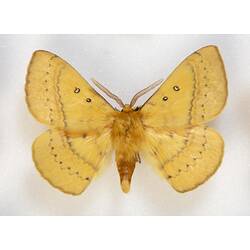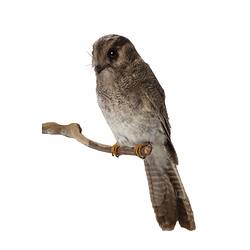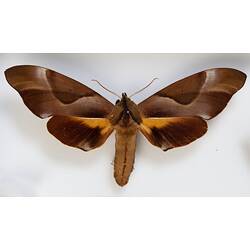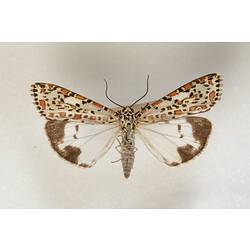As you follow your senses to Tyama, a deeper way of knowing Country, you will encounter objects from the museum's collection that will help you better understand the lives of Ngaloowoonkeel (moth), Nganeenganeeyt (bat) and Toortkoort (small schooling fish).
While exploring Sky Country as Ngaloowoonkeel (moth), stop to look in the cases embedded in the mirrored walls for clues about the world around you. Many moths feed on nectar, and in return pollinate flowering plants, by transferring pollen attached to the hairs on their bodies between flowers as they eat. Using fluffy antennae, male moths follow pheremones which female moths release when they are ready to mate. But being an important food source for many predators, danger is never far away. Look out for Kanameerata (Masked Owl), Yeerrathayarr (Australian Owlet-nightjar), Mamkayt (Tawny Frogmouth) and Tookan (Sugar Glider), who are lurking nearby.
As you head into Earth Country and become Nganeenganeeyt (bat), stop to admire the Bentwing Bats using echolocation to avoid stalactites hanging from the roof of a cave.
Hidden beneath the arches in Sea Country, you can discover specimens and models of some of the creatures swimming around you. There arepredators, like the mighty Thresher Shark who uses its huge tail to stun prey and Weertook (Australasian Gannet) who attacks unsuspecting fish from above. There are also friendlier critters like the beautiful Common Seadragons that camouflage among the seagrass and a Globefish who can inflate its spikey body to make it extremely hard to eat. You can also find a Doughboy Scallop who has up to 200 tiny blue eyes, and its nemesis the Eleven-armed Seastar who can prise open scallops using the sticky feet on its arms. As Toortkoot (a small schooling fish), you can find safety with your kin, but you are not the only creature who congregates in groups. Follow the Giant Spider Crabs as they march across the floor and you will find them stacked up in the corner, seeking safety as they prepare to moult their shells.
On emerging from the experience at Sunrise, you can find a selection of collection objects that can help you learn more about what you have seen. You will be able to spot the difference between the antennae of male and female Ngaloowoonkeel (moths) that allow them to smell Country. And be mesmerised by beautiful Palampee (butterflies) and a flying-fox that use their eyes to see Country. While the Nganeenganeeyt (bats) on display use their ears to hear Country, the Helena Gum Moth has special ridges on its wings that deflect the bat's calls and prevent it from being heard. Looking closely at the three Yeerrarr (salt-water fish) you may be able to spot their lines of neuromasts that allow them to feel country. And finally, stop to look at the tympanic bulla of Woolok (the Blue Whale), that allows the Oldest Storyteller to hear songs across the oceans, and like the songlines of First Peoples help guardians of Country know Country.
More Information
-
Keywords
Museum Victoria Exhibitions, natural sciences, shows & exhibitions
-
Authors
-
Article types
































